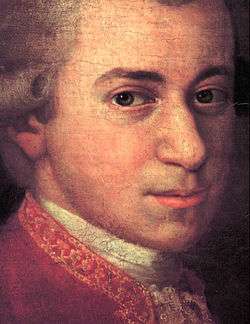Mass in C major, K. 220 "Sparrow"

The Sparrow Mass (German: Spatzenmesse) is a mass in C major K. 220/196b, Mass No. 9,[1] Missa brevis No. 5,[2] composed by Wolfgang Amadeus Mozart in 1775 or 1776 in Salzburg. The mass is sometimes termed a Missa brevis et solemnis, because it is short in a simple structure as a Missa brevis, but festively scored like a Missa solemnis with brass and timpani in addition to four soloists, strings and organ. It was possibly first performed on 7 April 1776 in a mass for Easter at the Salzburg Cathedral. The nickname is derived from violin figures in the Hosanna which resemble bird chirping.
Background
The mass may have been performed on 7 April 1776 during a celebration of Easter at the Salzburg Cathedral. According to a letter by Mozart, a copy was possibly loaned to the Heiligenkreuz Monastery the following year.[3] The mass got the nickname Spatzenmesse (Sparrow Mass) on account of "the violin figures in the Hosanna" of the Sanctus,[4] repeated after the Benedictus, which "recall the chirping of birds."[5]
The Sparrow Mass is one of a series of five masses Mozart composed in 1775–1776 (or possibly 1775–1777), all of them with clarini trumpets, and so in the "trumpet key" of C major.[6][7] Karl Geiringer notes that K. 220 was one of the models Franz Xaver Süssmayr used when completing Mozart's Requiem.[8]
Structure and scoring
The composition is short in duration as a Missa brevis. Mozart does not even include the fugal conclusions to the Gloria and the Credo normally expected.[5] It is richly orchestrated as a Missa solemnis, for four soloists (soprano, alto, tenor, bass), a four-part choir (SATB), two trumpets, three trombones, timpani, strings and organ, the latter supplying figured bass for most of the duration. The mass is therefore sometimes termed a Missa brevis et solemnis.[6]
The setting of the Latin Order of Mass is structured in six movements. In the following table of the movements, the voices, markings, keys and time signatures are taken from the choral score.
| No. | Part | Incipit | Vocal | Marking | Key | Time |
|---|---|---|---|---|---|---|
| 1 | Kyrie | Kyrie | SATB | Allegro | C major | |
| 2 | Gloria | Gloria | SATB + soloists | Allegro | C major | 3/4 |
| 3 | Credo | Credo | SATB + soloists | Allegro | C major | |
| Et incarnatus est | SATB | Andante | ||||
| Et resurrexit | SATB | Allegro | ||||
| 4 | Sanctus | Sanctus | SATB | Andante | C major | 3/4 |
| Pleni sunt coeli | SATB | Allegro | | |||
| Osanna | SATB | Allegro | ||||
| 5 | Benedictus | Benedictus | soloists | Andante | G major | |
| Osanna | SATB | Allegro | C major | |||
| 6 | Agnus Dei | Agnus Dei | SATB + soloists | Adagio | C major | 3/4 |
| Dona nobis pacem | SATB | Allegro | | |||
Following the example of Joseph Haydn (such as in the Nicolaimesse)[9] and Michael Haydn, Mozart in this mass recalls the music of the Kyrie in the Dona nobis, something which Franz Xaver Süssmayr did in his completion of Mozart's Requiem.[5] The Requiem contains an almost literal quotation from this mass in the Requiem aeternam.[10]
References
Notes
- ↑ Senn 1987.
- ↑ Humphreys 1990.
- ↑ Eisen & Keefe 2006, p. 274.
- ↑ B. 1990, p. 11.
- 1 2 3 Beyer 1991.
- 1 2 Eisen & Keefe 2006, p. 271–272, 274.
- ↑ Leisinger 2013.
- ↑ Landon 1956.
- ↑ Heartz 1905.
- ↑ Summer.
Bibliography
Scores
- Missa in C, KV 220 (196b): Score in the Neue Mozart-Ausgabe
- Missa brevis in C major, K.220/196b: Scores at the International Music Score Library Project
Books
- B., A. (1990). Zaslaw, Neal; Cowdery, William, eds. The Complete Mozart: A Guide to the Musical Works of Wolfgang Amadeus Mozart. New York: W. W. Norton & Co.
- Beyer, Franz (1991). Preface to Missa brevis et solemnis in C für Soli, Chor, Orchester und Orgel (Spatzen-Messe). Wiesbaden, Munich: Breitkopf & Härtel.
- Eisen, Cliff; Keefe, Simon, eds. (2006). The Cambridge Mozart Encyclopedia.
- Heartz, Daniel (1905). Haydn, Mozart, and the Viennese School: 1740–1780. New York: W. W. Norton & Co. p. 652.
- Humphreys, David; Landon, H. C. Robbins, eds. (1990). "Sacred Music". The Mozart Compendium: A Guide to Mozart's Life and Music. New York: Schirmer.
- Landon, H. C. Robbins; Mitchell, Donald (1956). The Mozart Companion. p. 373.
- Leisinger, Ulrich (2013). "Haydn's copy of the B-minor Mass and Mozart's Mass in C minor: Viennese traditions of the B-minor Mass". In Tomita, Yo; Leaver, Robin A.; Smaczny, Jan. Exploring Bach's B-minor Mass. Cambridge University Press. p. 236. ISBN 978-1-107-00790-1.
- Senn, Walter (1978). Neue Mozart-Ausgabe I/1/Abt. 1/2: Masses Vol. 2, Kritischer Bericht. p. b/1.
- Summer, J. Choral Masterworks from Bach to Britten: Reflections of a Conductor. Rowman & Littlefield. p. 28.
Further reading
- Green, Jonathan D. (2002). A Conductor's Guide to Choral-Orchestral Works, Classical Period: Volume 1: Haydn and Mozart. New York: Scarecrow Press. p. 28.
- Hugues, Rosemary (1974). Haydn. London: J. M. Dent & Sons.
- Schenbeck, Lawrence (1996). Joseph Haydn and the Classical Choral Tradition. Chapel Hill, NC: Hinshaw Music.
